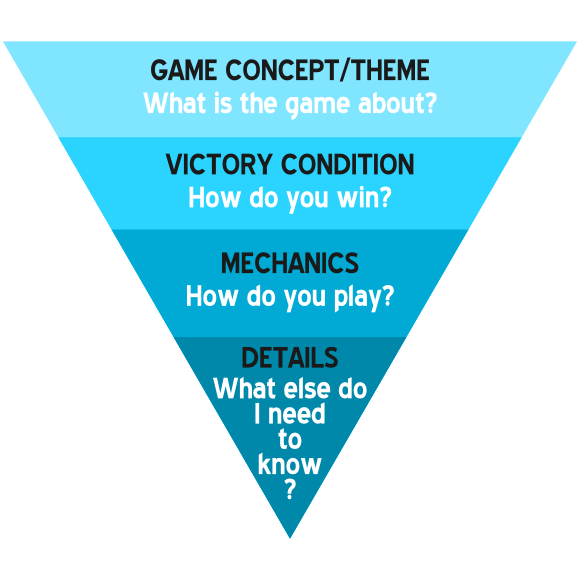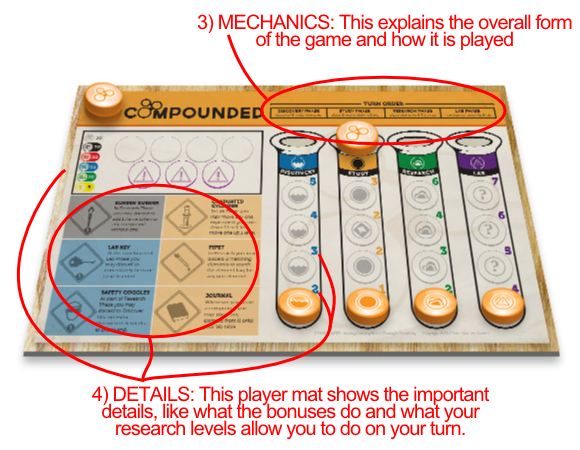How to Teach Games

Teaching games is like an upside down pyramid. Photo Credit: ©hassansagheer via DeviantArt, Inverse Pyramid, Louvre Museum. I do not own this material.
I’ve had several friends tell me that I am good at teaching games. So I sat down for a while with a nice brew and thought about why they might have said that, and about what makes someone good at teaching games. So I’ve postulated and hypothesized some ideas that I want to lay out for you today.
There are some rules and some guidelines. But the overall idea of how to teach games can be summarized in this upside down pyramid table with the idea being that you teach from the top down:
 Before we get into those concepts I want to address Rule #1 of teaching games…
Before we get into those concepts I want to address Rule #1 of teaching games…
RULE #1: Know How To Play!
That seems pretty straightforward, right? It is really annoying when someone is all excited to teach you a game and then they keep looking through the rules for all the weird little oddities. Don’t be that person.
Learn the game. Read the rules. Watch videos about how to play the game. Set the game up. Pretend to play it solo. Do whatever you need to do to know the game before you attempt to teach it to others. Don’t waste their time.
Ok… glad I got that off my chest. Now let’s hop on top of that inverted pyramid!

1) Explain the GAME CONCEPT/THEME
I always like to start at the beginning. Tell the players what the game is about. Tell them about the theme. Tell them the overall idea of the game. Players will want to know what is exciting about the game. They will want to somehow relate to the theme, if at all possible. At a bare minimum, players will want to understand what the theme is so that they can try to immerse themselves in it.
Games are supposed to be fun and it is often more fun if you can immerse yourself in the theme*.
* Does not apply to abstract games.

2) Explain the VICTORY CONDITION
Now that your players know what the game is about, they’ll want to know how to win or at least how/when the game ends.
I think this is very important to know early on. I dislike when someone is teaching a game and they have told you about 30 different rules and then someone says, “How do you win?” That’s annoying.
So after I explain what the game is about, I tell them how they win the game.

3) Explain the MECHANICS
Players should now know the victory conditions. It is now time to explain how they can reach those victory conditions.
At this point you will teach the mechanics of the game. You will be teaching the actual things that you will be doing during the game. This is the most time-intensive portion of teaching a game. Also, there are a few guidelines during this portion of teaching that I like to follow:
- Teach along the flow of the game
- Teach the basics of each portion of the game… save the details for later.
- As you teach, remind the players how the mechanics relate to the victory condition.
- Give examples of how one decision can help you make the next.
Teaching along the flow of the game means don’t skip around. If the game follows a progression of things, teach them in order.
Teaching the basics means telling players the overall idea of what is happening. The details can come later on.
Remember to relate the different phases of the game to the victory conditions whenever possible. That way players can quickly learn which mechanics are the most helpful along their path to victory.
And giving examples of how decisions affect future decisions can be really helpful.

4) Explain the “necessary” DETAILS
Once you have taught the basics of the mechanics, go back and fill in the details. Once players know the overall flow of the game, then revisit each of the portions of the game and dive deep enough where people aren’t lacking anything that they will need to know.
These are the sorts of things players will need to know, but don’t need to know until after they have learned the general flow of the game.

Got all that? Here’s an example…
 I’ll attempt to “teach” you how to play Compounded from designer Darrell Louder and publisher Dice Hate Me Games. I love this game and it is a great example for this article. If you haven’t played it, I highly recommend it. Let’s start with step 1) Concept/Theme.
I’ll attempt to “teach” you how to play Compounded from designer Darrell Louder and publisher Dice Hate Me Games. I love this game and it is a great example for this article. If you haven’t played it, I highly recommend it. Let’s start with step 1) Concept/Theme.
1) CONCEPT/THEME: You are a lab manager working on the greatest compounds known to man. Your objective in the game is to manage your lab workbench better than your opponents. To do that you will have to complete compounds, increase your experiment levels, and gain the most atomic points.
It’s that easy and quick. Give the players the basic idea of why they are playing the game, and what their overall objective is while playing.
2) VICTORY CONDITION: To win the game you will have to score the most Atomic Points. To earn Atomic Points you will have to complete compounds. To complete compounds you will have to place elements on these cards (*points to cards). Once you have completed a compound you will earn points and bonuses, which I’ll explain in a moment. The game ends when someone reaches 50 Atomic Points (or condition A, or condition B, etc.).
Okay, in that portion I started from the top and worked my way down. Score Points. How? Complete Compounds. How? Place elements on compounds. Start at the top and then fill in the details. It allows players to understand the grand scheme of things.
3) MECHANICS: Now that you know how to earn points, let’s discuss how we actually play. Each round is made up of a few different phases. (*points to top of player mats where the phases are listed). First is the Discovery phase where we will draw elements from the bag and possibly trade with other players. After Discovery is the Study phase where we will claim compounds by placing our discs on them. After the Study phase is the Research phase where we can place elements on compounds and try to complete them. After the Research phase comes the Lab Managing phase where we check for completed compounds and restock the lab with new compounds.
So when I teach Compounded I like to run quickly through the four phases of a round before I give too much detail about any one of them. This way players will become familiar that each round of the game has four phases where you are doing certain things. Once players understand the flow of the game, then I get into the details.
3) DETAILS: Those are the different phases. Let’s discuss each one. So in the Discovery phase players will draw a number of elements shown by their DISCOVERY research level. Each player starts the game at “2.” Also during the discovery phase players will have the opportunity to trade things. You can trade anything EXCEPT Atomic Points and research levels. No future trades are necessarily binding. That depends on your real life integrity. Then in the Study phase you each have one disc to place on a compound. …
I could go on and on, but the idea here is that for each phase of a game you should be mentioning the details. Like during the explanation of the Lab Managing phase of Compounded you should point out the little symbols on the corners of the cards that either give you a bonus or start a lab fire or whatever they may be. Players will want to know those things.
So that’s the basic way that I teach a game of Compounded to new players. I follow the four major steps shown in the inverted pyramid.
I want to point out that Dice Hate Me did an awesome thing by listing the phases of the round right on each player mat. Here is a picture showing how Dice Hate Me incorporated my Steps 3 & 4 onto the player mat to help players learn and play the game:
Having the overview of the game flow and the details where all players can see it serves as a constant reminder throughout the game. It also helps to prevent players from asking the same questions over and over again.

I know that not everyone will agree with how I think games should be taught. If you don’t agree, let me know about your way. I’d love to hear how others teach games. If you have a way that works really well, post it in the comments! Thanks for reading!
Posted on February 28, 2014, in Board Games, Lessons Learned, The Boards and tagged board games, compounded, teach board games, teach games, teaching games. Bookmark the permalink. 11 Comments.

Your method is close to my own. i do the over view but then I start playing most games right after explaining the mechanics needed for the first choice or decision, then introduce more mechanics and details as they become necessary for player’s to make a choice during play. If possible I always demonstrate using my own turns first, or playing a few rounds with open information. there are some games out there that really lend themselves well to teaching mechanics during a first play. my favorite example is Carcassonne. only explain how all the various tiles score as they are drawn from the bag, it keeps the amount of rules front loading to a minimum.
A bad habit to watch for is other players who already know how to play interrupting an explanation with details they are excited about. This typically confuses a new player. This is easy to stop if you game with the same people often and you let them know it is rude to interrupt.
Great post! I think it is worth repeating: Never, ever, invite people over to play a game if you have never read the rules. Nobody has fun that first hour of reading the rule book one rule at a time.
Another point would be to not get bogged up in strategic advice in the middle of the explanation. No one understands it because they don’t know the rules yet!
Excellent point Sig. I detest it when someone is teaching rules and “gives examples” of wht someone might choose to do during a certain action/phase. Without context, it’s just noise on the signal.
http://snapguide.com/guides/explain-board-game-rules/
Reblogged this on TGIK Games Blog.
Game reviewers should also follow this format. There have been times when I’ve watched a review and they jumped into the mechanics of the game before giving any information that told me what I am trying to accomplish with those mechanics.
Pingback: News Bits: 3/3/2014 | iSlaytheDragon
Pingback: Today in Board Games Issue #141 - Board Game Hour, TEK giveaway continues! - Today in Board Games
Pingback: How do we evaluate games? – Teachability | Games Precipice
Pingback: Laying Down the Law (a guide to rulebook writing) | iSlaytheDragon
Pingback: How to (Speed) Pitch Your Game | Boards and Barley